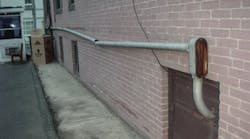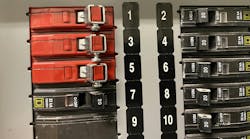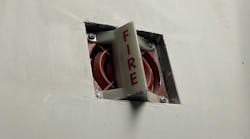How well do you know the Code? Think you can spot violations the original installer either ignored or couldn't identify? Here's your chance to moonlight as an electrical inspector and second-guess someone else's work from the safety of your living room or office. Joe Tedesco, who has a knack for finding shoddy electrical work, did the dirty work and found this mess. Now it's your turn to identify the violation.
Find the Answer
110.27(B) In locations where electric equipment is likely to be exposed to physical damage, enclosures or guards are required to be so arranged and of such strength as to prevent such damage. See also, 300.10 where metal raceways for conductors are required to be metallically joined together into a continuous electric conductor and shall be connected to all boxes, fittings, and cabinets so as to provide effective electrical continuity.
This installation violates the rules outlined in 300.11(B) and 300.11(C) of the 2002 NEC. Raceways are only allowed to be used as a means of support for other raceways, cables, or nonelectric equipment when; (1) the raceway or means of support is identified for the purpose; or (2) the raceway contains power supply conductors for electrically controlled equipment and is used to support Class 2 circuit conductors or cables that are solely for the purpose of connection to the equipment control circuits; or (3) the raceway is used to support boxes or conduit bodies in accordance with 314.23 or to support luminaires (fixtures) in accordance with 410.16(F). In addition, cable wiring methods shall not be used as a means of support for other cables, raceways, or nonelectrical equipment. Chapters 7 and 8 also make it clear that you shall not strap, tape, or attach (by any means) wiring to the exterior of any conduit or other raceway as a means of support.





